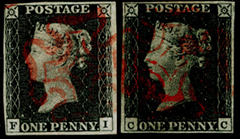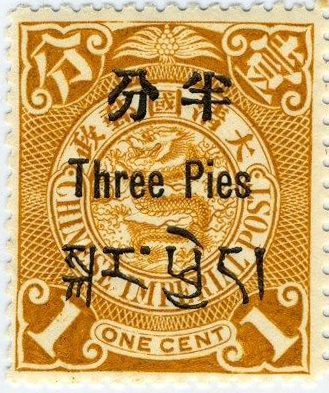 First Issues Collectors Club
of stamps and philatelic material
First Issues Collectors Club
of stamps and philatelic material
Home - Catalog - Categories - Index - Journal - Exhibits - Auctions - Forgeries - Join
 First Issues Collectors Club
of stamps and philatelic material
First Issues Collectors Club
of stamps and philatelic material
Home - Catalog - Categories - Index - Journal - Exhibits - Auctions - Forgeries - Join
| first issues > countries > tibet |
| Asia | 9 |
Imperforate, native paper, no gum, no watermark, typographed.
| Description | Printings | Scott | SG ‡ | Mi | Y&T | |
|---|---|---|---|---|---|---|
| December, 1912-50, ink | ||||||
1 Khakang (1/6 trangka) green |
15 | 1 | 1A, 1Aa | |||
1 Karmanga (1/3 trangka) blue |
10 | 2 | 2A, 2Ab | |||
1 Karmanga (1/3 trangka) ultra |
10 | 2a | 2Aa | |||
1 Tschakey (1/2 trangka) violet |
14 | 3 | 3A, b-c | |||
1 Shokang (2/3 trangka) carmine |
14 | 4 | 4A, b-c | |||
1 Shokang (2/3 trangka) carmine "POTSAGE" |
14 | 4a | 4Aa | |||
1 Trangka vermilion |
8 | 5 | 5A, 5Aa | |||
1922, ink |
||||||
1 Sang (6 2/3 Trangka) sage green |
5 | 6 | 6A, 6Aa | |||
1920+, gloss enamel paint |
||||||
1 Khakang (1/6 trangka) green |
1a | 1B | ||||
1 Karmanga (1/3 trangka) blue |
2b | 2B | ||||
1 Tschakey (1/2 trangka) purple |
3d | 3B, 3Ba | ||||
1 Shokang (2/3 trangka) carmine |
4h | 4B, 4Bc | ||||
1 Shokang (2/3 trangka) carmine "POTSAGE" |
4l | 4Ba | ||||
1 Trangka carmine |
5c | 5B | ||||
‡ Gibbons' numbering approach is unusual. This design of stamp was in use from 1912 through to 1950 and Gibbons lists all 38 years as 1A-6A for ink and 1B-5B for stamps produced with gloss enamel paint: colour and other variants are identified with suffixes such as the 4Aa (ink) / 4Ba (paint) for the POTSAGE misprint. Scott takes a slightly more sensible approach
Forgeries exist of all values.
After the fall of the Qing dynasty in 1911 the independent Tibetan government established its own postal service, and issued its own stamps. These were only valid for internal use, as Tibet did not join the Universal Postal Union. Mail going out of Tibet usually went via India, and had to be franked with Indian stamps.
The first issue was only for sale in the capital, Lhasa, until 1913. Some printings were made with European enamel paint instead of ink.
A "printing plate" was created by hand carving 12 stamp images, arranged as three rows of four stamps each, in a wooden block, one block for each denomination. Therefore, each stamp in a sheet is slightly different from the others, making them platable. The stamps were printed on request form the Post Offices and every printing has a different shade.
The stamps occur as lithographs on European paper as well as xylographs on Tibetan paper. Some believe that the European lithographs issues are forgeries, while others believe that the first issue of this set was made in London in 1912 on European paper, and only later reprinted by xylography in Tibet on local paper.
The 1 Sang stamps were only discovered in 1950. The status of the 1 Sang stamp is not yet clear; the high denomination 1 Sang = 6 2/3 Trangka was not needed for postal purposes. It is believed that this stamp could have been used, along with other denominations, for telegraphic purposes (fee: one Sang per word).
The place to start looking for more information on the stamps of Tibet might be Tibet Handbook by Rainer Fuchs.
You should also try Geoffrey Flack's Fine Stamps & Postal History . Though a commercial site it also provides links to information on the stamp issues.
 |
Chinese Offices |
| 1911 China Sc1 Tibet SG-C1 |
Occupation
China invaded Tibet in 1909 and opened several post offices using both plain, and later overprinted, Chinese stamps. Following the Chinese Revolution of 1911, the Tibetans revolted against Chinese rule and the troops were forced to retreat back to China via India. The Dalai Lama was restored
Sources: ScS, SGP17.
† Image from Sandafayre, described as, "TIBET - 1912 First issue fine mint selection with 1/6th t green and dull yellow green, 1/3rd t blue, ½t violet, lilac, 2/3rd t carmine, 1t vermilion, 1s blue green. Lovely fresh group. (8 stamps)" [accessed 4th July 2016].
| Page created 18 Nov 2015 | Page updated 05-Sep-2022 |